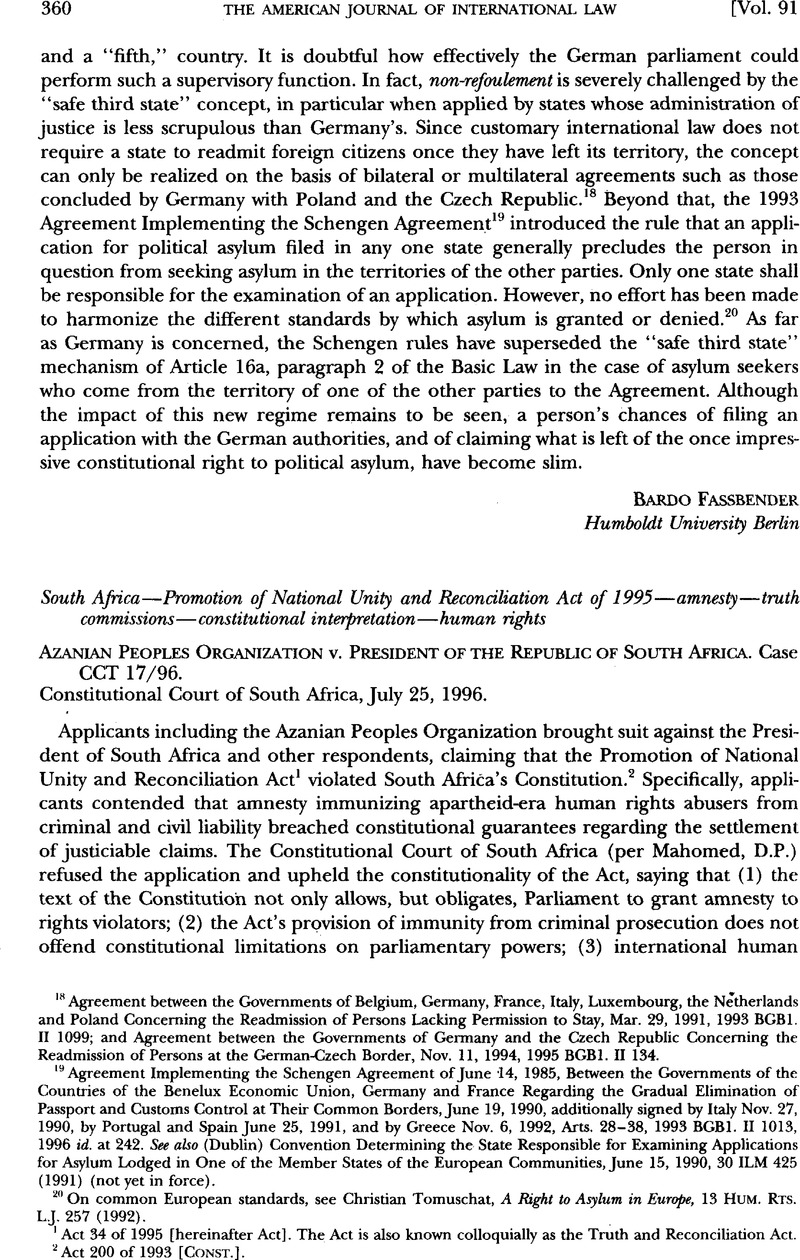Article contents
Azanian Peoples Organization v. President of the Republic of South Africa
Published online by Cambridge University Press: 27 February 2017
Abstract

- Type
- International Decisions
- Information
- Copyright
- Copyright © American Society of International Law 1997
References
1 Act 34 of 1995 [hereinafter Act]. The Act is also known colloquially as the Truth and Reconciliation Act.
2 Act 200 of 1993 [Const. ].
3 For a trenchant analysis of the political, legal and economic dimensions of the apartheid era and their effects on U.S. foreign policy, see Robert Kinloch Massie , Loosing the Bonds : The United States and South Africa in the Apartheid Years (forthcoming 1997).
4 Supra note 2.
5 Case CCT/96, para. 2 [hereinafter AZAPO].
6 Id. Reconciliation was an especially difficult goal since the laws of South Africa had previously compelled racial oppression. For a review of the legislative acts that created the legal mandate for apartheid, see Leonard Thompson , AH istory of South Africa 190–200 (1990).
7 Const , epilogue.
8 Act §3(1).
9 Id. §3(1)(b).
10 Id. §20(7).
11 Const. §22.
12 AZAPO, para. 14 (quoting Const , epilogue) (emphasis added).
13 Const. §22.
14 AZAPO, para. 21.
15 The Geneva Conventions on which applicants relied were the Convention for the Amelioration of the Condition of the Wounded and Sick in Armed Forces in the Field, Aug. 12, 1949, 6 UST 3114, 75 UNTS 31; Convention for the Amelioration of the Condition of the Wounded, Sick, and Shipwrecked Members of Armed Forces at Sea, Aug. 12, 1949, 6 UST 3217, 75 UNTS 85; Convention Relative to the Treatment of Prisoners of War, Aug. 12, 1949, 6 UST 3316, 75 UNTS 135; Convention Relative to the Protection of Civilian Persons in Time of War, Aug. 12, 1949, 6 UST 3516, 75 UNTS 287; Protocol I Additional to the Geneva Conventions of August 12, 1949, and Relating to the Protection of Victims of International Armed Conflicts, June 8, 1977, 1125 UNTS 3; Protocol II Additional to the Geneva Conventions of August 12, 1949, and Relating to the Protection of Victims of Non-International Armed Conflicts, June 8, 1977, 1125 UNTS 609.
16 AZAPO, para. 26.
17 Id.
18 AZAPO, para. 27.
19 Id.
20 Diane F. Orentlicher, Settling Accounts: The Duty to Prosecute Human Rights Violations of a Prior Regime, 100 Yale L.J. 2537, 2539 (1991).
21 AZAPO, para. 22.
22 See, e.g., Orentlicher, supra note 20, at 2541. See also Henry J. Steiner & Philip Alston , International Human Rights in Context : Law , Politics , Morals 1084–1108 (1996).
23 For a response to Orentlicher, see Nino, Carlos S., The Duty to Punish Past Abuses of Human Rights Put into Context: The Case of Argentina , 100 Yale L.J. 2619 (1991).Google Scholar See also Jorge, Correa S., Dealing with Past Human Rights Violations: The Chilean Case After Dictatorship , 67 Notre Dame L. Rev. 1455 (1992);Google Scholar Zalaquett, Jose, Balancing Ethical Imperatives and Political Constraints: The Dilemma of New Democracies Confronting Past Human Rights Violations , 43 Hastings L.J. 1425 (1992).Google Scholar
- 2
- Cited by


